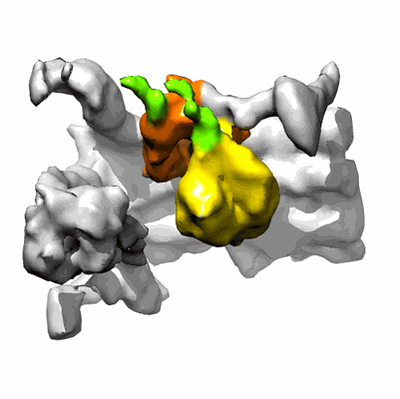EMD-6868
A microtubule-dynein tethering complex regulates the axonemal inner dynein f (I1)
EMD-6868
Subtomogram averaging41.0 Å
 Deposition: 24/12/2017
Deposition: 24/12/2017Map released: 28/03/2018
Last modified: 28/03/2018
Sample Organism:
Chlamydomonas reinhardtii
Sample: Inner dynein f
Deposition Authors: Kubo T, Hou Y, Cochran DA, Witman GB, Oda T
Sample: Inner dynein f
Deposition Authors: Kubo T, Hou Y, Cochran DA, Witman GB, Oda T
A microtubule-dynein tethering complex regulates the axonemal inner dynein
Abstract:
Motility of cilia/flagella is generated by a coordinated activity of thousands of dyneins. Inner dynein arms (IDAs) are particularly important for the formation of ciliary/flagellar waveforms, but the molecular mechanism of IDA regulation is poorly understood. Here we show using cryoelectron tomography and biochemical analyses of Chlamydomonas flagella that a conserved protein FAP44 forms a complex that tethers IDA f (I1 dynein) head domains to the A-tubule of the axonemal outer doublet microtubule. In wild-type flagella, IDA f showed little nucleotide-dependent movement except for a tilt in the f β head perpendicular to the microtubule-sliding direction. In the absence of the tether complex, however, addition of ATP and vanadate caused a large conformational change in the IDA f head domains, suggesting that the movement of IDA f is mechanically restricted by the tether complex. Motility defects in flagella missing the tether demonstrates the importance of the IDA f-tether interaction in the regulation of ciliary/flagellar beating.
Motility of cilia/flagella is generated by a coordinated activity of thousands of dyneins. Inner dynein arms (IDAs) are particularly important for the formation of ciliary/flagellar waveforms, but the molecular mechanism of IDA regulation is poorly understood. Here we show using cryoelectron tomography and biochemical analyses of Chlamydomonas flagella that a conserved protein FAP44 forms a complex that tethers IDA f (I1 dynein) head domains to the A-tubule of the axonemal outer doublet microtubule. In wild-type flagella, IDA f showed little nucleotide-dependent movement except for a tilt in the f β head perpendicular to the microtubule-sliding direction. In the absence of the tether complex, however, addition of ATP and vanadate caused a large conformational change in the IDA f head domains, suggesting that the movement of IDA f is mechanically restricted by the tether complex. Motility defects in flagella missing the tether demonstrates the importance of the IDA f-tether interaction in the regulation of ciliary/flagellar beating.

